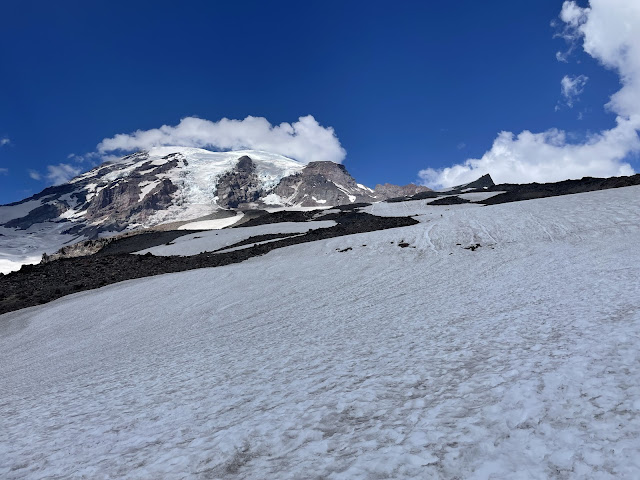Autumn is here! Though with the gorgeous sunny days, it feels like we are still getting to soak up a little more summer. People who have ventured up to Camp Muir have had gorgeous views with very few people around.
 |
| View of Mount Rainier's south side from Pebble Creek |
The climbing season on Mount Rainier has slowed down significantly, and already stopped for many of the guide services. Along the Muir Snowfield are cracks and skeletal ice making travel difficult to and from Camp. Above Camp Muir the climber's route across the Cowlitz Glacier has seen a bit more active rockfall than usual, with one big slide stopping right at the boot pack. There's significant rockfall hazard and tricky loose-rock-on-steep-ice terrain to cross to get to Ingraham Flats. From Ingraham Flats to the Cleaver presents various challenges as well. Near High Crack, there are several large hollowly bridged crevasses going latitudinally and longitudinally. As for route adjuncts, at High Crack (around 11,400 ft.) there is a horizontal triple ladder and getting onto the cleaver there are also some fixed pickets. The route above the Cleaver is very difficult to navigate due to large crevasses, and with the freezing levels staying above 10,000 feet all of the glaciated portions of the route seem to be changing rapidly. It's definitely an advanced climbing route - not the "easier standard route" that it typically is.
 |
| The traverse onto the Cleaver from the Ingraham Glacier |
Climbers attempting a summit climb at this time of the year should be prepared to be entirely self-sufficient. The climbing ranger season is winding down and we aren't regularly staffing either of the high camps. Any emergency rescue is not just hours, but most likely days away - which will feel like a very long time for any ill/injured climber. We cannot stress this enough - be prepared for self-rescue and self-care in the event of an emergency - and choose to turn around, or not push upward, if you're unfamiliar with the mountain and it's hazards and/or the skills needed to navigate, perform crevasse rescue, ascend a rope, etc.
 |
| Thin snow bridges exist on route between Ingraham Flats and the Cleaver |
Permits are still available in-person until October 12th at the Longmire Wilderness Information Center and the White River Wilderness Information Center. Getting an in-person permit allows you to talk to a ranger and get updated weather and route information, it is definitely the way to go! Check out this page for updated hours of the Wilderness Information Centers. At Paradise there is a Self-Registration area at the Old Ranger Station (see this blog post for more details). Don’t forget to pay the annual climbing fee before going up!














.jpg)






















.jpg)









